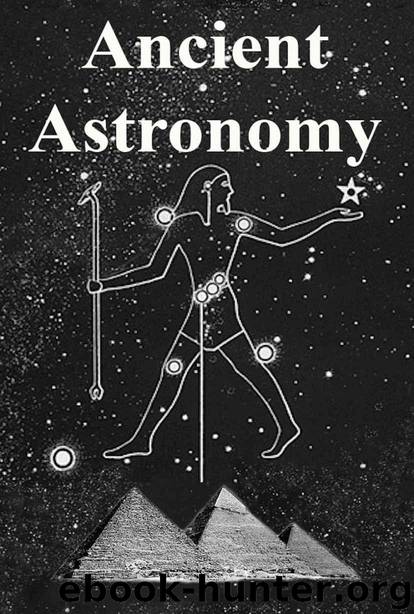Ancient Astronomy: India, Egypt, China, Maya, Inca, Aztec, Greece, Rome, Genesis, Hebrews, Christians, the Neolithic and Paleolithic by Belmonte Juan Antonio & Kragh Helge & Pankenier David W. & Campion Nicholas & da Silva Cândido Marciano & Gullberg Steven R. & Iwaniszewski Stanisław & Kak Subhash & Aggarwal Yash & Malville J. McKim

Author:Belmonte, Juan Antonio & Kragh, Helge & Pankenier, David W. & Campion, Nicholas & da Silva, Cândido Marciano & Gullberg, Steven R. & Iwaniszewski, Stanisław & Kak, Subhash & Aggarwal, Yash & Malville, J. McKim [Belmonte, Juan Antonio]
Language: eng
Format: epub
Publisher: Cosmology Science Publishers
Published: 2015-10-19T21:00:00+00:00
Figure 1. Group E astronomical alignments. Symbols: SSSR – Summer Solstice Sunrise, ESR – Equinox Sunrise, WSSR – Winter Solstice Sunrise. The photo made from the eastern stairway, above the first body, about 3.5 meters above the ground level. Photo: Stanisław Iwaniszewski.
Group E structures were built on a small natural promontory surrounded by bajos (namely the Bajo de Juventud, see Puleston 1983, fig. 1), or low-lying seasonally flooded swamps. The pyramid E-7 was built at the place highest elevation and the plaza was artificially leveled (Ricketson and Ricketson 1937, pp. 44-45). The place offered unrestricted views to the north-east, east and south-east. Today, no distant landscape features can be seen beyond the immediate setting, but the map (Puleston 1983, fig. 1) shows that the skyline features are located between 4.5 and 7.5 km eastward, and if there was limited tree cover in the way, they would have been visible from Group E. It may be speculated that during the dry season, from January through May, when bajos partially dried out, visibility conditions were improved.
Astronomically significant events might have been discovered at this spot in the distant past and a series of rounded platforms (Structures E, F and G) erected during the Middle Formative Period (600- 300 BCE) could have been connected to this fact (Ricketson and Ricketson 1937, pp. 109-13, 134, 136-137; Rosal et al. 1993, p. 72). Archaeoastronomical interpretations of Group E alignments can be traced back to the phase 2 of Late Formative (300 - 100 BCE) when the earliest versions of pyramid E-7sub-1 and of East Platform E-16-1 were erected. In providing a clear material barrier between the plaza and the bajos, the elongated and high platform (h = 4 m) also served to replace the natural horizon with the built one. The data provided by Aveni and Hartung (1989, pp. 444-445, Table 35.1) imply that top of the platform was high enough to coincide with the skyline extending over thebajos, as seen from the top of E-7sub-1 (h = 3.5 m). The bajos behind the platform remained invisible. This was only a very crude approximation intended to mark the passage of the sun along the eastern and now artificial horizon; the total length of the platform, as reported by Rosal et al. (1993, p. 73) yields 62 meters and is not long enough to be projected onto the annual path of the sun along the eastern horizon, as seen from the spot onto E-7sub1. The only access to the top of the pyramid was through a stairway placed on its eastern side.
About two hundred years later, during the Late Formative phase 5 (100 – BCE – 100 CE) both structures were again modified. The top of E-7sub2 was raised to 8.07 m, while the platform E-16-2 to some 4.52 m only, making the whole arrangement astronomically non-functional. Any observer located atop the pyramid would have seen the sunrise much above the top of the platform, along the skyline features created by the hills on the other side of bajos.
Download
This site does not store any files on its server. We only index and link to content provided by other sites. Please contact the content providers to delete copyright contents if any and email us, we'll remove relevant links or contents immediately.
| Aeronautics & Astronautics | Astronomy |
| Astrophysics & Space Science | Comets, Meteors & Asteroids |
| Cosmology | Mars |
| Solar System | Star-Gazing |
| Telescopes | UFOs |
Tools of Titans by Timothy Ferriss(7803)
Turbulence by E. J. Noyes(7693)
Astrophysics for People in a Hurry by Neil DeGrasse Tyson(4998)
Secrets of Antigravity Propulsion: Tesla, UFOs, and Classified Aerospace Technology by Ph.D. Paul A. Laviolette(4974)
Design of Trajectory Optimization Approach for Space Maneuver Vehicle Skip Entry Problems by Runqi Chai & Al Savvaris & Antonios Tsourdos & Senchun Chai(4837)
Room 212 by Kate Stewart(4730)
Pale Blue Dot by Carl Sagan(4612)
The David Icke Guide to the Global Conspiracy (and how to end it) by David Icke(4376)
A Journey Through Divination and Astronomy by Publishing Pottermore(4247)
Apollo 8 by Jeffrey Kluger(3511)
Goodbye Paradise(3441)
Losing the Nobel Prize by Brian Keating(3424)
COSMOS by Carl Sagan(3346)
The Five People You Meet in Heaven by Mitch Albom(3333)
Brief Answers to the Big Questions by Stephen Hawking(3239)
How to Read Water: Clues and Patterns from Puddles to the Sea (Natural Navigation) by Tristan Gooley(3236)
How to Read Nature by Tristan Gooley(3073)
The Order of Time by Carlo Rovelli(3072)
A Brief History of Time by Stephen Hawking(2819)
